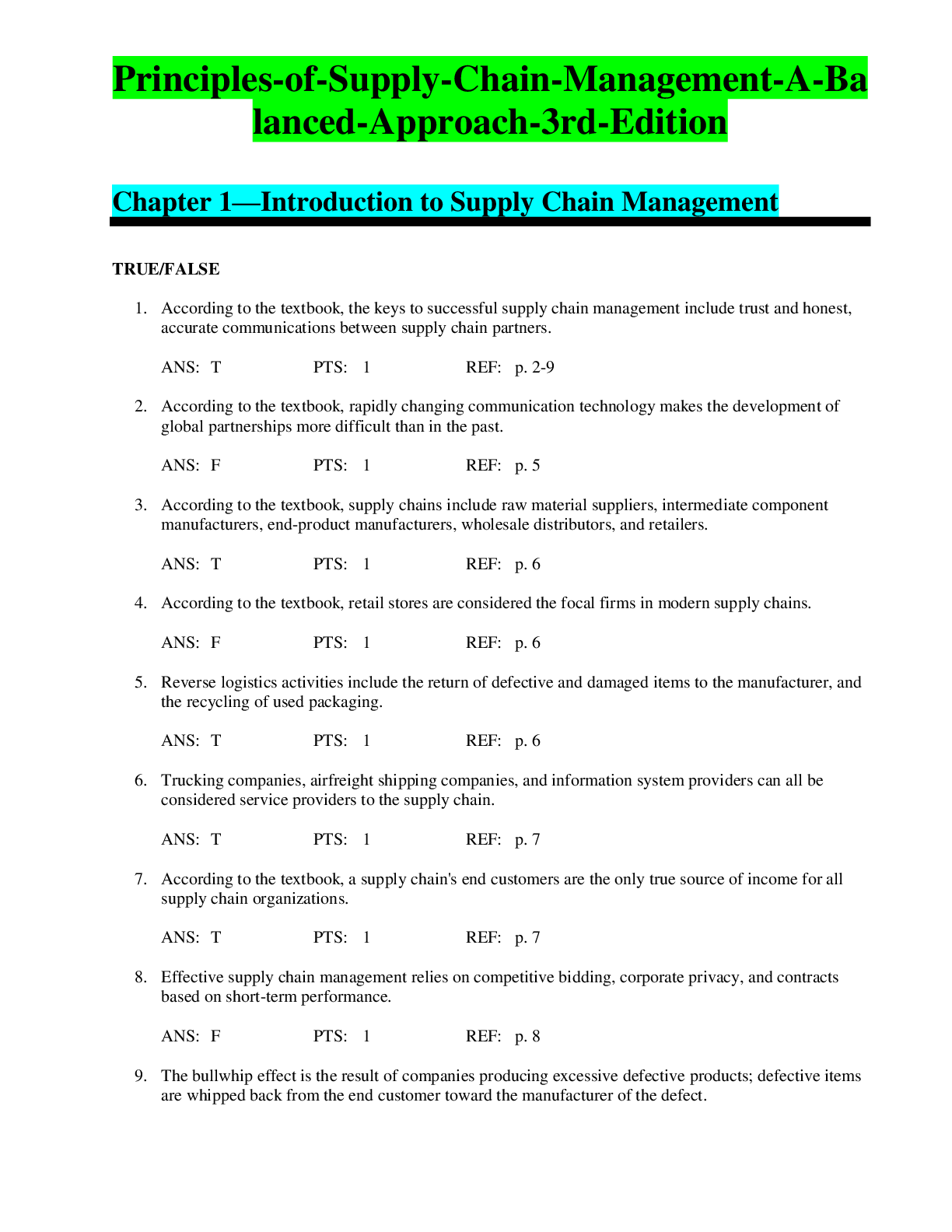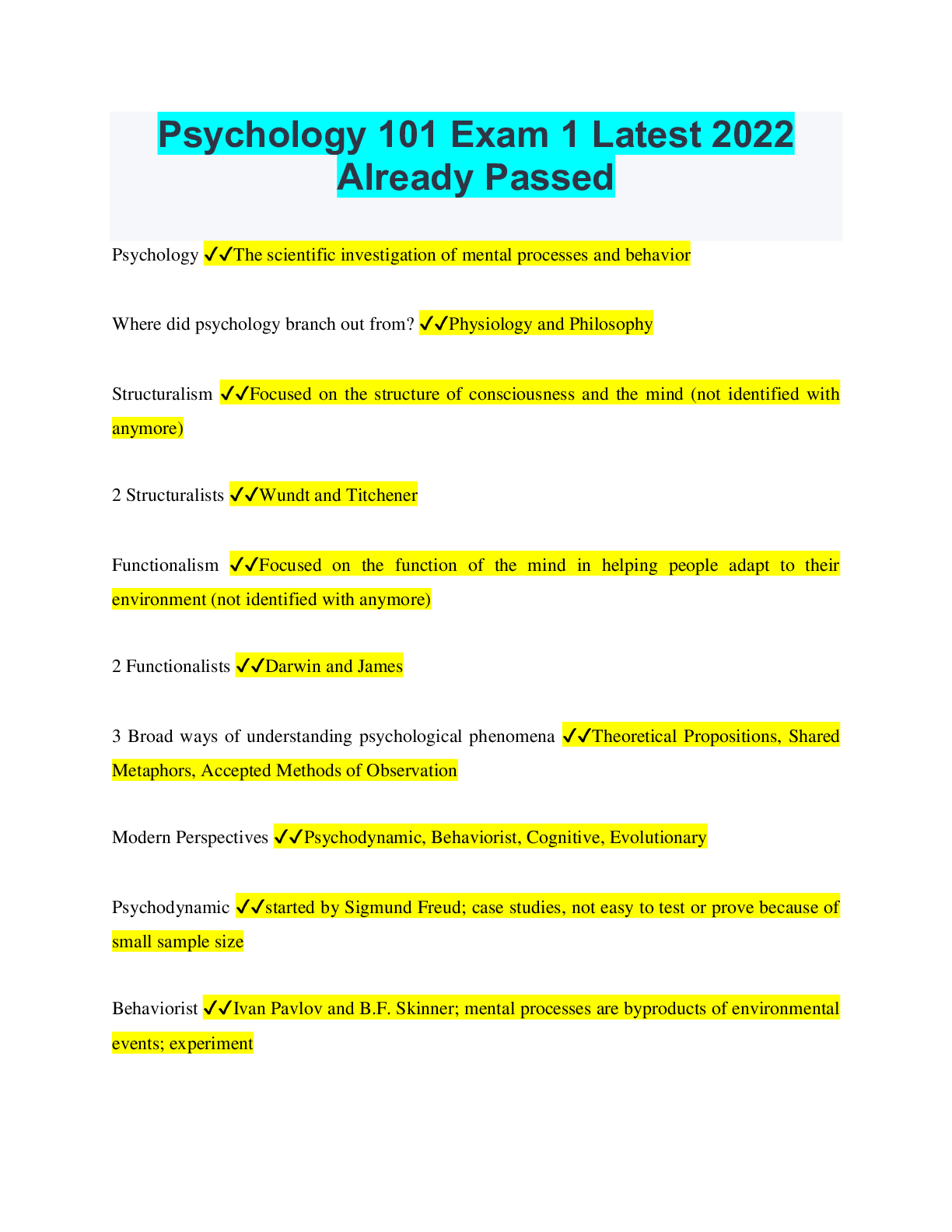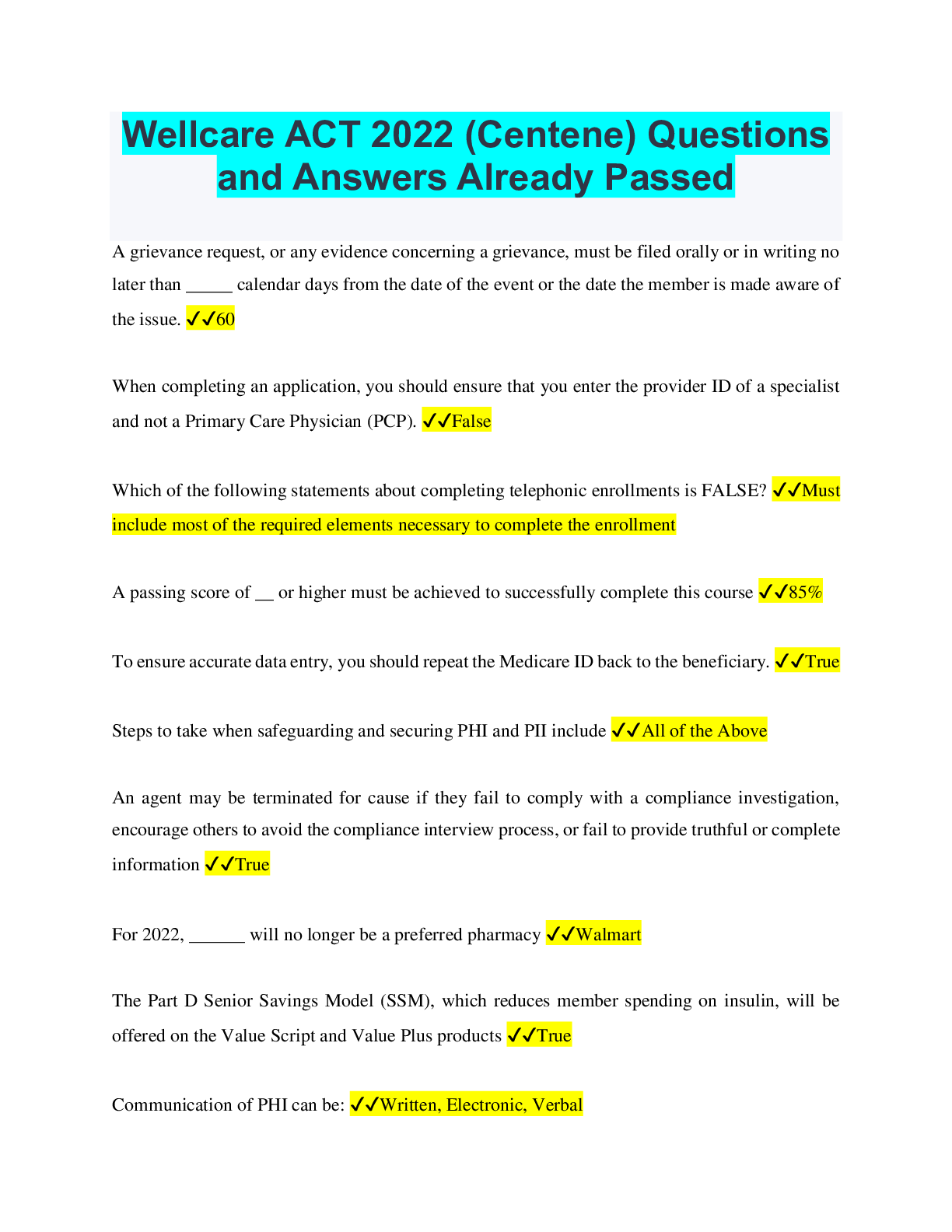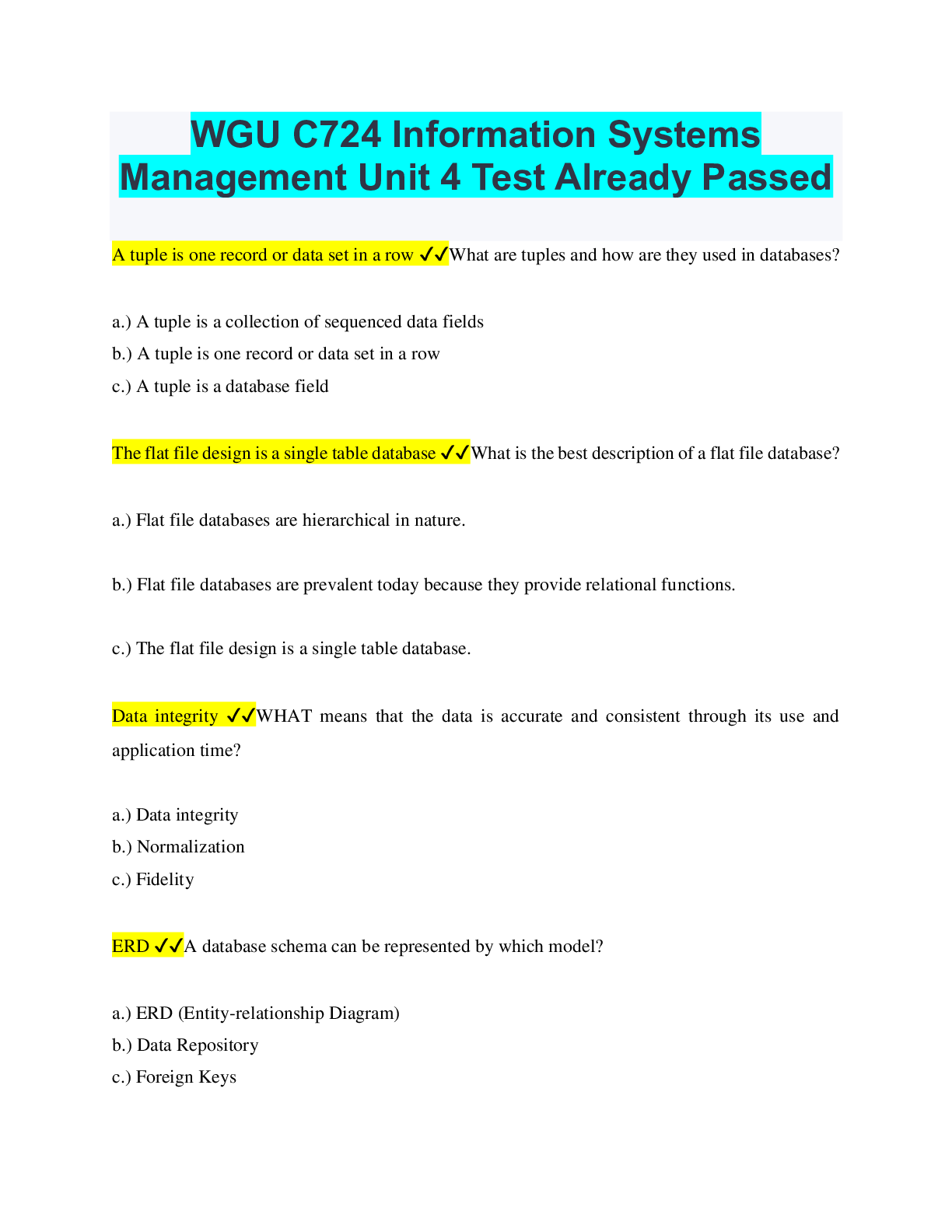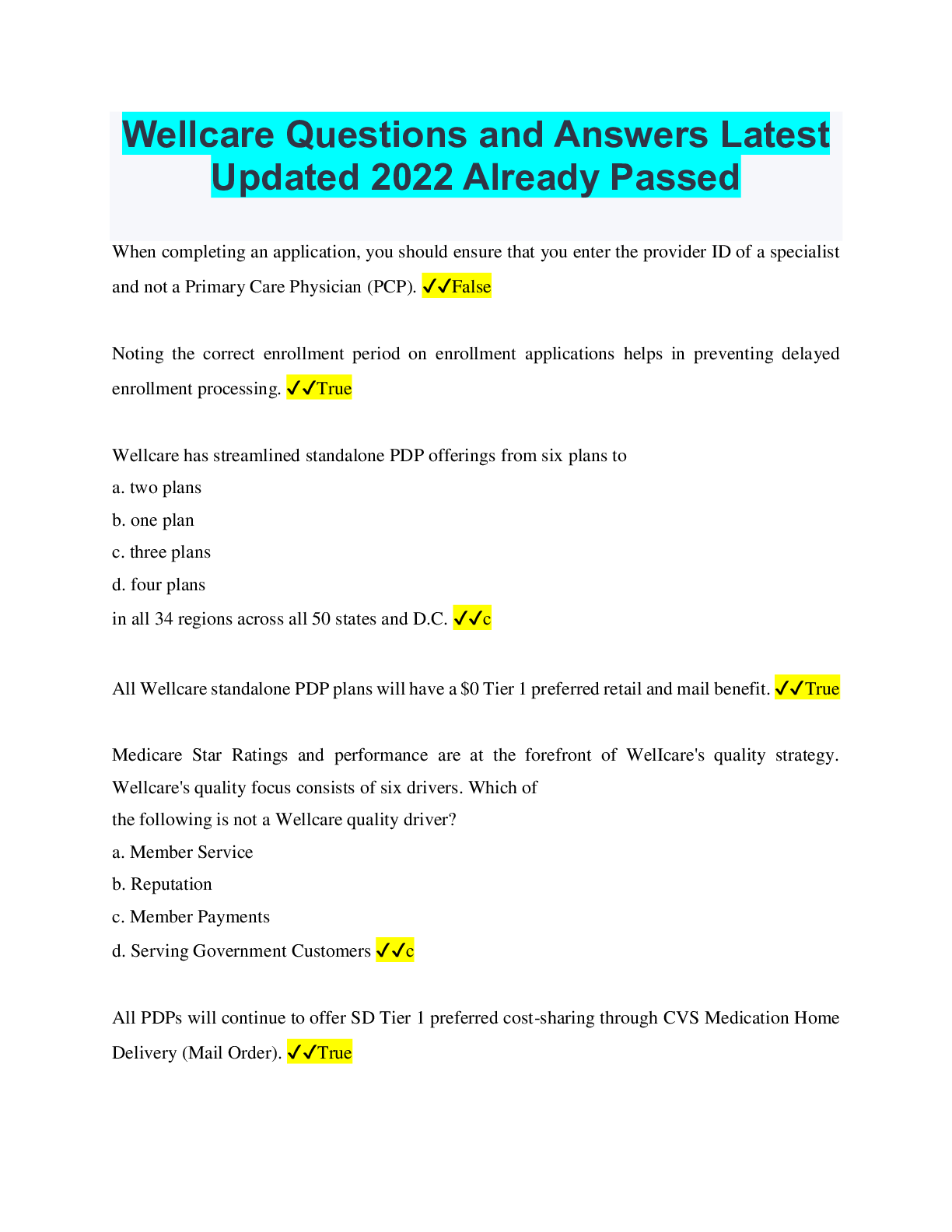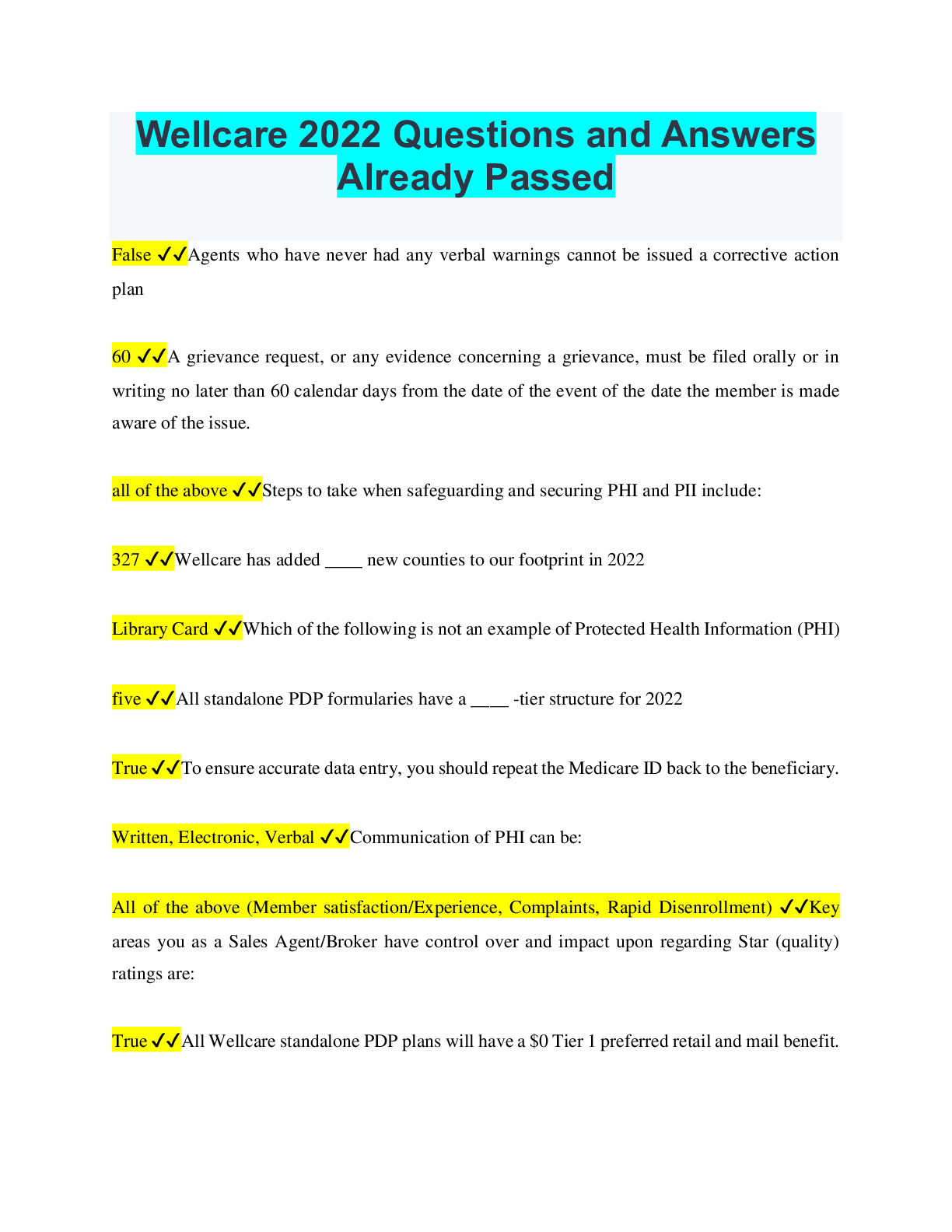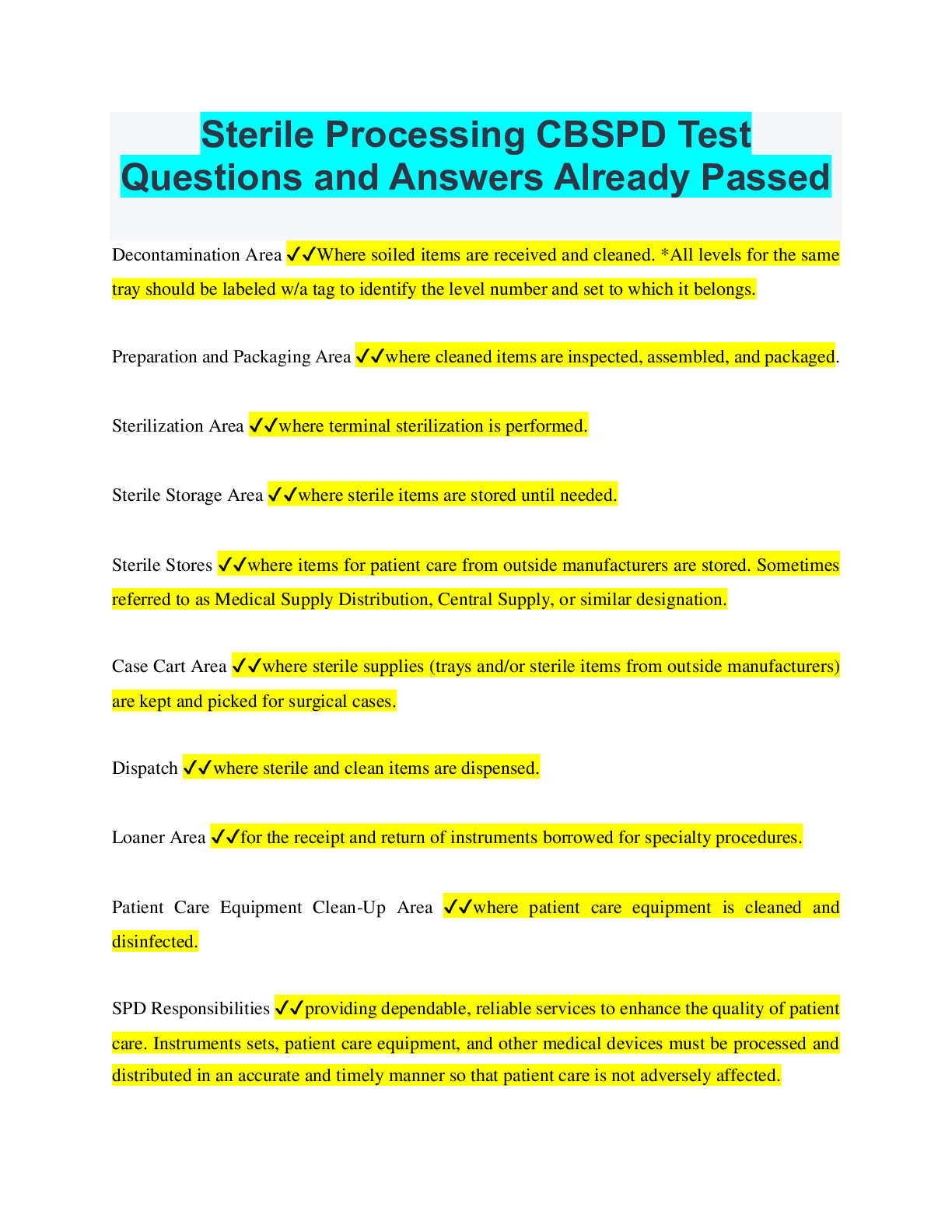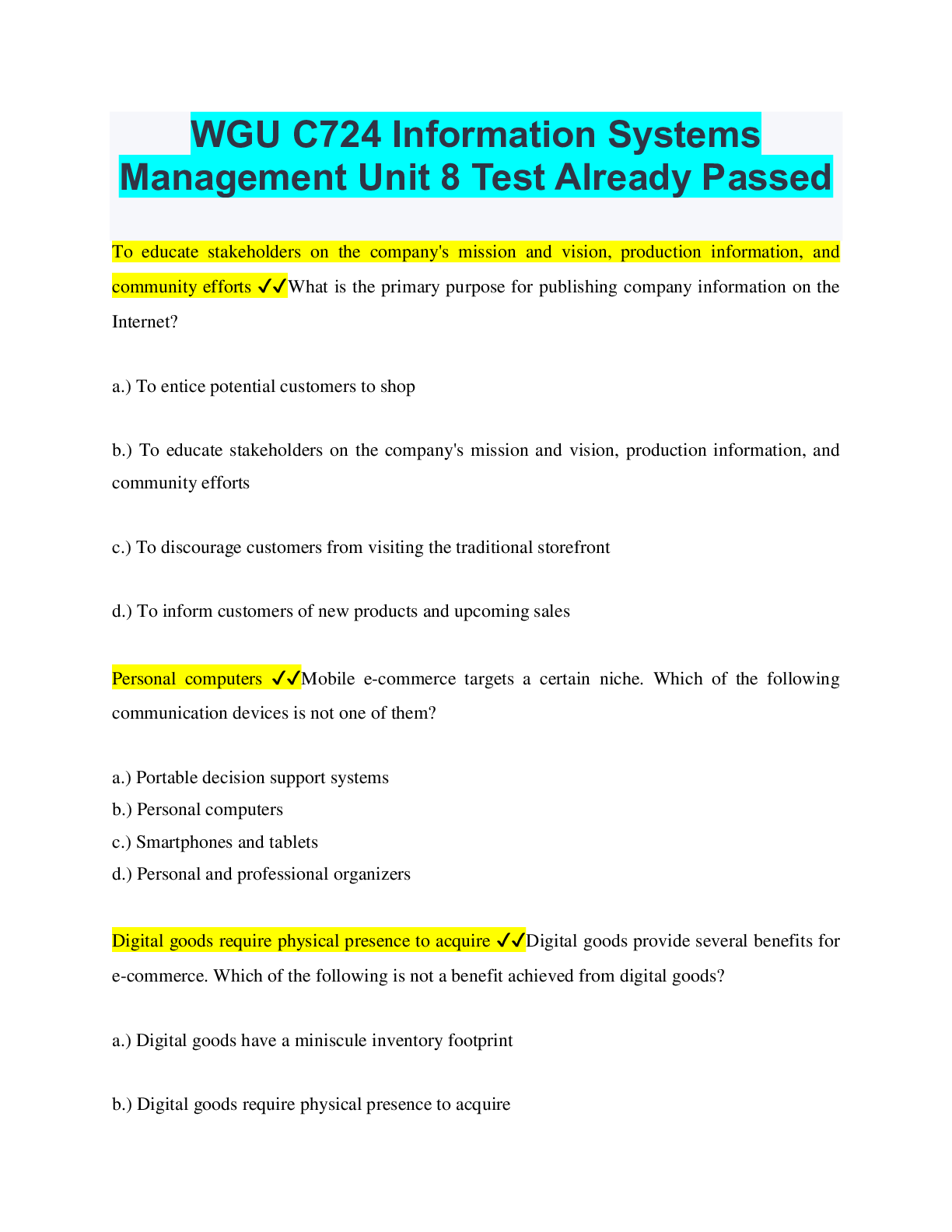Operations Management > QUESTIONS & ANSWERS > WGU - C720 Operations and Supply Chain Management Already Passed. Rated A (All)
WGU - C720 Operations and Supply Chain Management Already Passed. Rated A
Document Content and Description Below
WGU - C720 Operations and Supply Chain Management Already Passed Ethics ✔✔Are a sense of what is right and wrong that guide behavior. This set of standards is often more stringent than legal st... andards. Test questions on the OA will require you to understand right and wrong regarding common business practices. Anything related to fraud, wrong doing, dishonesty, etc., even if it is to protect the company, is considered unethical business practices. Sustainability ✔✔Is defined broadly in operations and supply chain management as the ethical issues an organization faces to balance financial performance while maintaining social responsibility standards and a responsible environmental profile. Competitive Advantage ✔✔Is a capability that customers value, such as short delivery leadtime or high product quality that gives an organization an edge against its competition. o Some scholars use the acronym VIRAL as a framework for competitive advantage. The advantage must provide Value to consumers; it should be Inimitable (not easily imitated), Rare, and an organization must have the Aptitude (capability) and Lifespan (sustainability) to earn appropriate returns on the advantage. SWOT Analysis ✔✔Is a simple but useful technique for analyzing an organization's strengths and weaknesses and the opportunities and threats that it faces. It helps a company focus on its strengths, minimize threats, and take the greatest possible advantage of opportunities available. SWOT Analysis ✔✔Is a useful framework for understanding the strengths and weaknesses internal to an organization, and for identifying both the opportunities and the threats related to externalfactors. Identification of strengths, weaknesses, opportunities, and threats is important because SWOT Analysis can assist in future planning to achieve objectives. The four elements of SWOT Analysis: ✔✔Strengths Weaknesses Opportunities The first of the four elements of SWOT Analysis: ✔✔Strengths:These are the characteristics of a business or project that lend an advantage within the scope of the study. The second of the four elements of SWOT Analysis: ✔✔Weaknesses: These characteristics of a business or project result in a disadvantage, relative to others, The third of the four elements of SWOT Analysis ✔✔Opportunities: These are elements that the project could exploit to its advantage. The forth the four elements of SWOT Analysis ✔✔Threats: These elements in the competitive environment could create trouble for the business or project. Productivity ✔✔Is a mathematical calculation; it is the ratio of the outputs achieved divided by the inputs consumed to achieve those outputs. o As productivity increases, organizations can do the same work with less effort, or can do more work with the same effort. Increases in productivity reduce costs, lower prices, and provide a basis for competing in world markets. 6 Types of Inventory ✔✔Raw MaterialsWork-in-process (WIP) Finished Goods Replacement parts inventory Supplies Transportation (pipeline) Raw Materials ✔✔These parts and materials are obtained from suppliers and are used in the production process. Work-in-process (WIP) ✔✔These are partly finished parts, components, subassemblies, or modules. Finished Goods ✔✔Items are ready to ship to the customer. No more work is required. Replacement parts inventory ✔✔These are maintained to replace other parts in machinery or equipment as those parts wear out. Supplies ✔✔Parts or materials are used to support the production process but not usually a component of the product. These items, such as lubricant and cutting tools, are consumed in the production process. Transportation (pipeline) ✔✔The portion of inventory that is in the process of being shipped through the distribution system. 4 types of demand ✔✔Peak demandSeasonal demand Unexpected demand Chase demand Peak demand ✔✔Which occurs in response to planned events such as advertising, publicity or promotion. The release of a popular game franchise's latest version often causes peak demand for a few days or weeks. Seasonal demand ✔✔As shoppers adjust their purchase velocity in line with holidays, especially Christmas. But Halloween, Thanksgiving and even St. Patrick's Day also create seasonal demand for certain kinds of merchandise. Unexpected demand ✔✔Which occurs due to a usually-unexpected event. For example, an underdog school may upset a favorite during the NCAA's basketball tournament, causing a run on their merchandise. Chase demand ✔✔Occurs when a company has to adjust production by rates to match demand by varying the workforce and using overtime. Companies vary the workforce by adding or reducing the number of employees on duty at any given time. And they may choose to provide overtime by asking workers to stay on thejob beyond their normally scheduled time. Stock-Out ✔✔Occurs when inventory is depleted. This may occur for a variety of reasons. For example, an organization may underestimate demand, experience disruptions in its supply chain or delays in production that lead to late delivery of the product. Perpetual and Periodic Inventory Systems ✔✔Are systems that companies use to track inventory. Although mostly used separately, they can also be used together.Perpetual Inventory System ✔✔Continuously monitors inventory levels and is also called continuous review system. Requires human input (i.e. cashier) and the ordering of more inventory is triggered by reorder point. Periodic Inventory System ✔✔Randomly monitors inventory levels and is also called the fixed order interval system. Not expensive to implement or maintain. Perpetual Inventory System ✔✔-Used for inventory that requires an exact inventory balance at all times. -Most suitable for big businesses, large retail stores and/or Banks -Most appropriate for high value and high volume items -Best for accurate financial statements -Expensive to implement and maintain Periodic Inventory System ✔✔-Requires a physical count to know exact inventory balances -Used when a supplier will only deliver at specific time intervals (during open window) -Most appropriate for low value and low volume items -Most appropriate for small businesses -Inexpensive to implement and maintain ABC analysis ✔✔-Has been developed to determine which inventory items should receive the highest level of control. -By multiplying the dollar value of each item by its annual usage, a dollar usage value can be obtained. Two models used to help companies control the cost of ordering ✔✔The EOQ (Economic Order Quantity) and EPQ (Economic Production Quantity) are two models used to help companies control the cost of ordering, receiving, and holding inventory. EOQ (Economic Order Quantity) ✔✔Is used:For inventory that doesn't require production when demand is constant and known when cost per unit does not depend on order quantity Most appropriate for retail stores or companies that order finished goods EPQ (Economic Production Quantity) ✔✔Is used: For inventory that will be used in production When incremental ordering and depletion of inventory is allowed Also called production order quantity Most appropriate for manufacturing and production companies Ordering cost and Holding cost ✔✔Can be described with the analogy of two children sitting on a seesaw. When one goes up, the other goes down, and vice versa. Although it costs money to replenish inventory, it also costs money to hold that inventory. Holding costs, also called carrying costs ✔✔May include costs paid for storage space, interest paid on borrowed money to finance the inventory, and any losses incurred due to damage or obsolescence. Quantity discount model ✔✔A discount offered in price for ordering above a specified amount Transportation discounts ✔✔A discount offered on shipping cost for ordering above a specified amount Revenue Sharing ✔✔When 2 or more companies partner and divides the profits received based on an agreement between all parties involved. Reserve Capacity ✔✔When a company stores, or pays another company to store, excess inventory to be used for unexpected demand.Quality ✔✔the degree to which a specific product conforms to its design characteristics or specifications the amount of a specific, desired attribute the capacity to satisfy customers' needs consistently meeting or exceeding the customer's needs and expectations Is everyone's responsibility in the organization Internal orientation of quality ✔✔Directly measure characteristics of the product or service, such as the number of packages delivered on time or the thickness of an engine part based on manufactures specification. External orientation of quality ✔✔Fitness for use for the customer or the capacity to satisfy customer's needs. Quality function deployment (QFD) ✔✔Taking customer expectations and transforming them into specific actions designed to meet those expectations Service Quality ✔✔The following five dimensions of quality are often used by customers to judge service quality. Understanding these dimensions helps firms to define quality and determine what steps are needed to improve quality. Reliability ✔✔Ability to perform the promised service dependably and accurately. Responsiveness ✔✔Willingness to help customers and provide prompt service.Assurance ✔✔Knowledge and courtesy of employees and their ability to convey trust and confidence. Empathy ✔✔Provision of caring, individualized attention to customers. Tangibles ✔✔Appearance of physical facilities, equipment, personnel, and communication materials, including access and effectiveness of Internet-based information. Quality of Goods ✔✔In examining the dimensions of quality for goods, it is important to recall that a good is tangible, and therefore, direct contact between the customer and the employees who make the good does not often occur. As a result, the factors that comprise the quality of goods are quite different from the factors that comprise quality service. Performance ✔✔Primary operating characteristics of a product. Features ✔✔Secondary characteristics that supplement the product's basic functioning. Reliability ✔✔Length of time a product will function before it fails, or the probability it will function for a stated period of time. Conformance ✔✔Degree to which a product's design and operating characteristics match preestablished standards. Durability ✔✔Ability of a product to function when subjected to hard and frequent use. Serviceability ✔✔Speed, courtesy, and competence of rep [Show More]
Last updated: 1 year ago
Preview 1 out of 23 pages
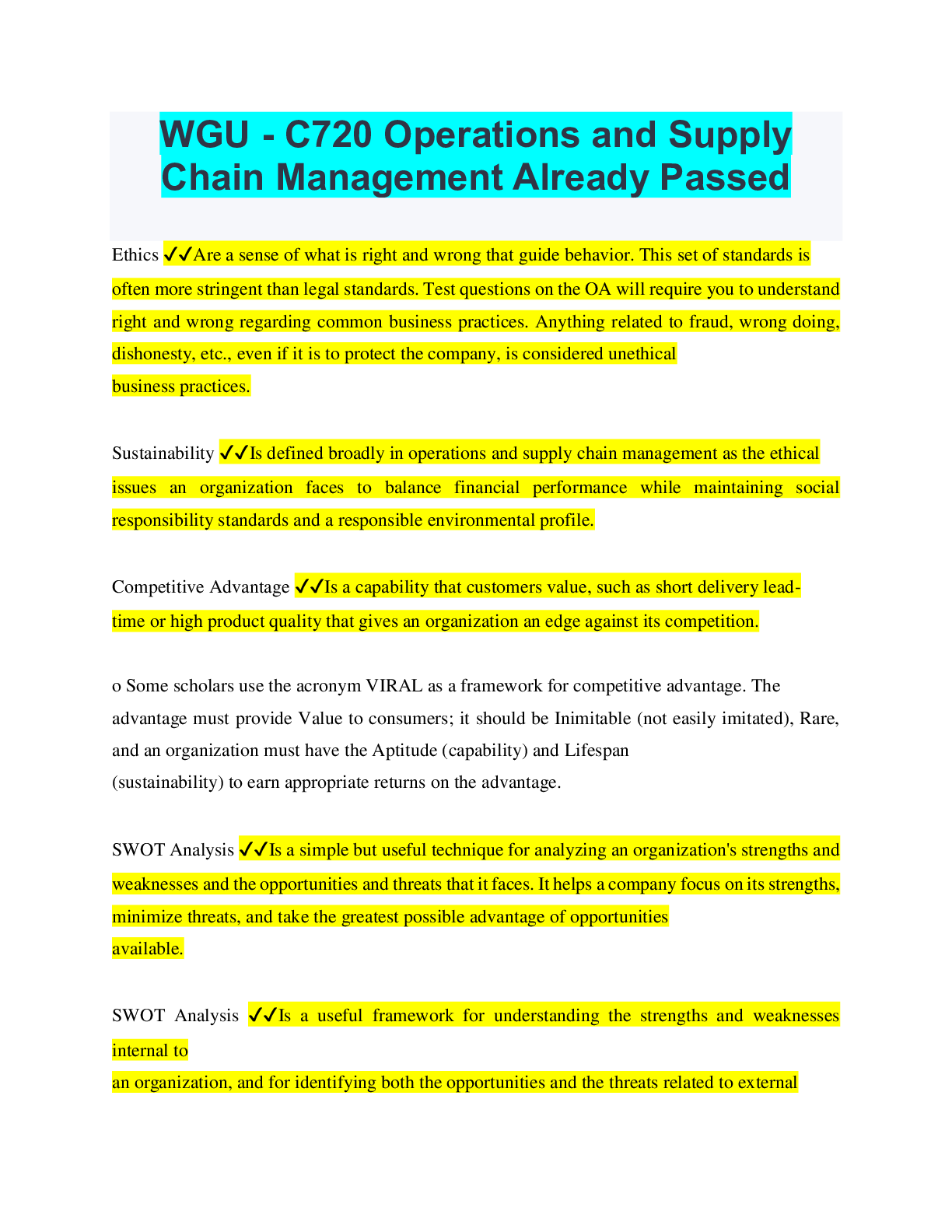
Reviews( 0 )
Document information
Connected school, study & course
About the document
Uploaded On
Sep 29, 2022
Number of pages
23
Written in
Additional information
This document has been written for:
Uploaded
Sep 29, 2022
Downloads
0
Views
77



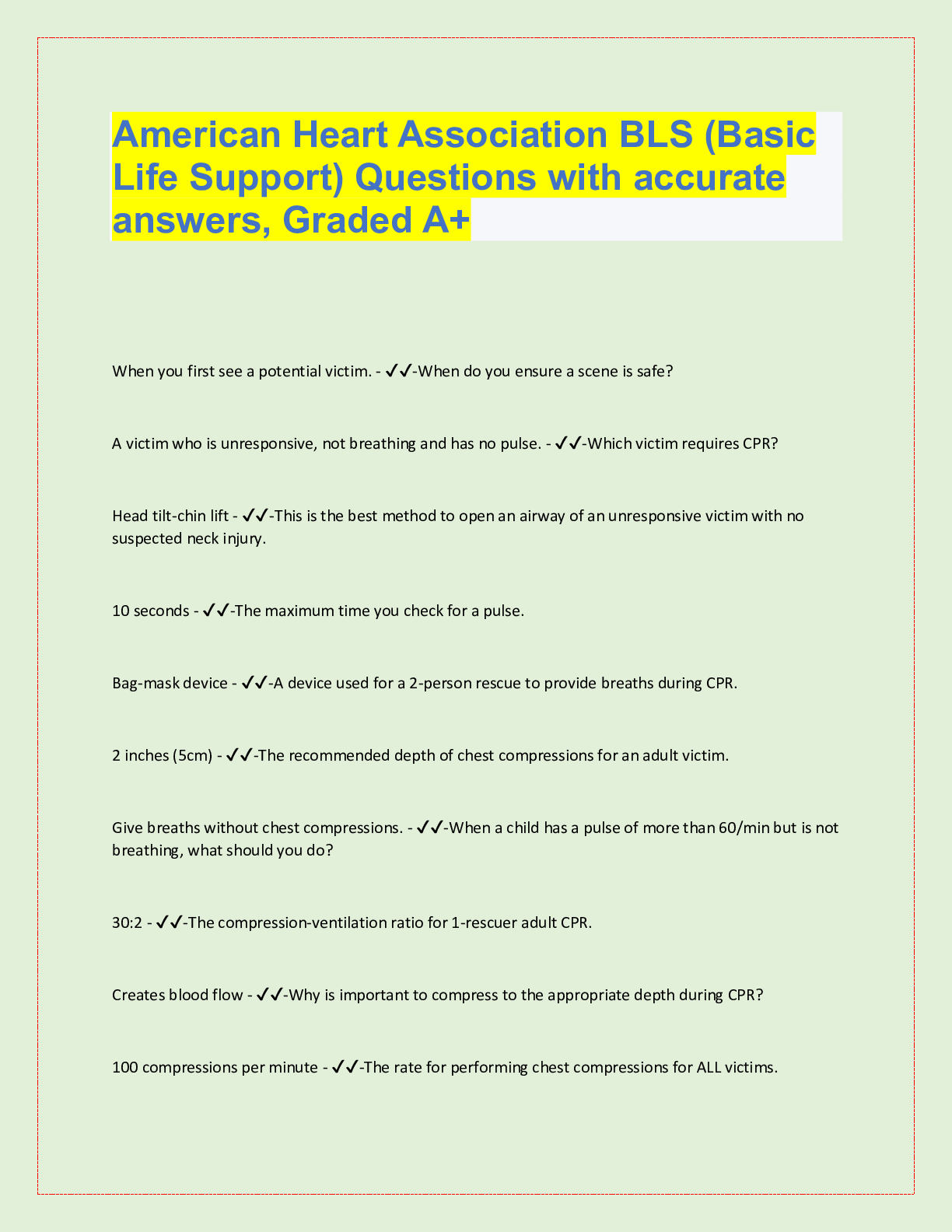


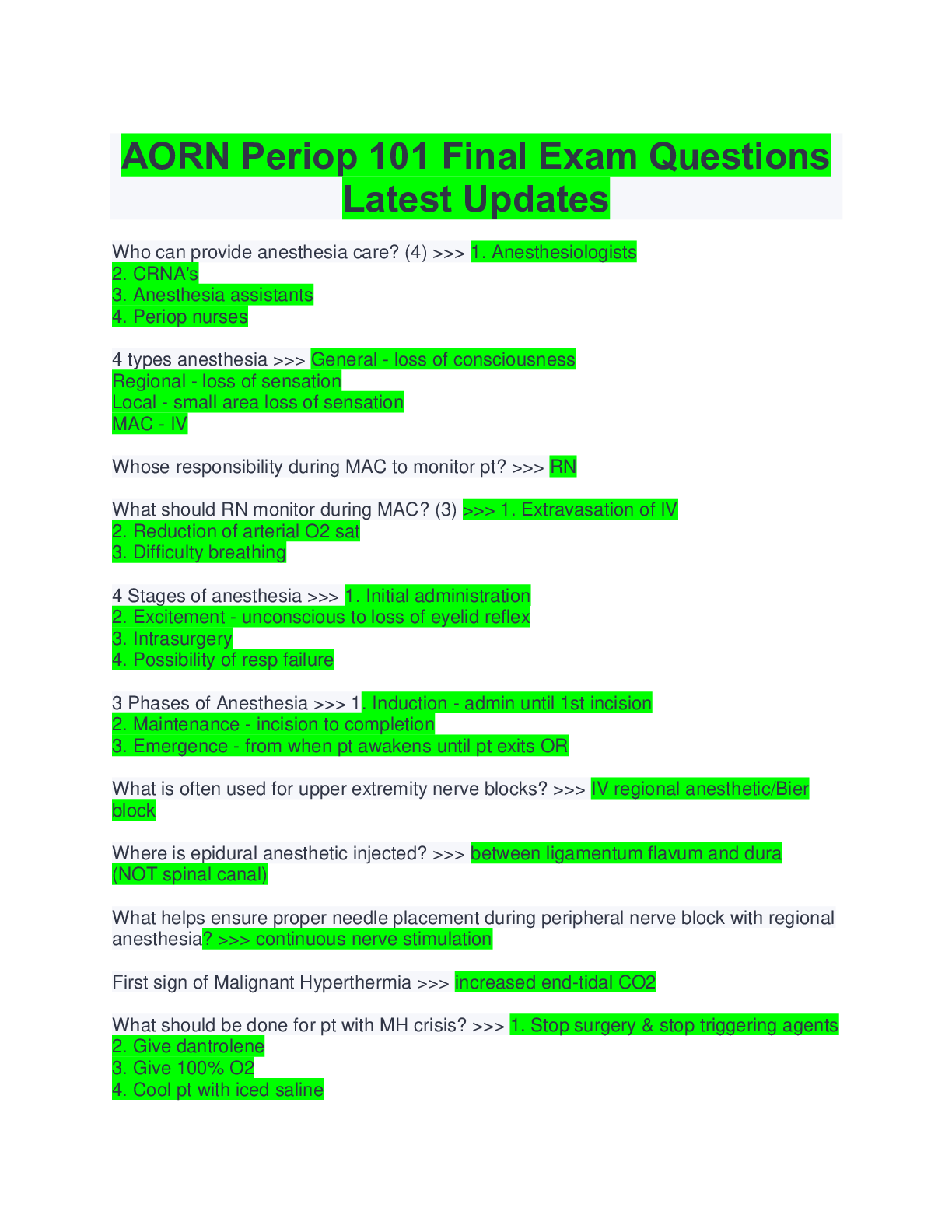






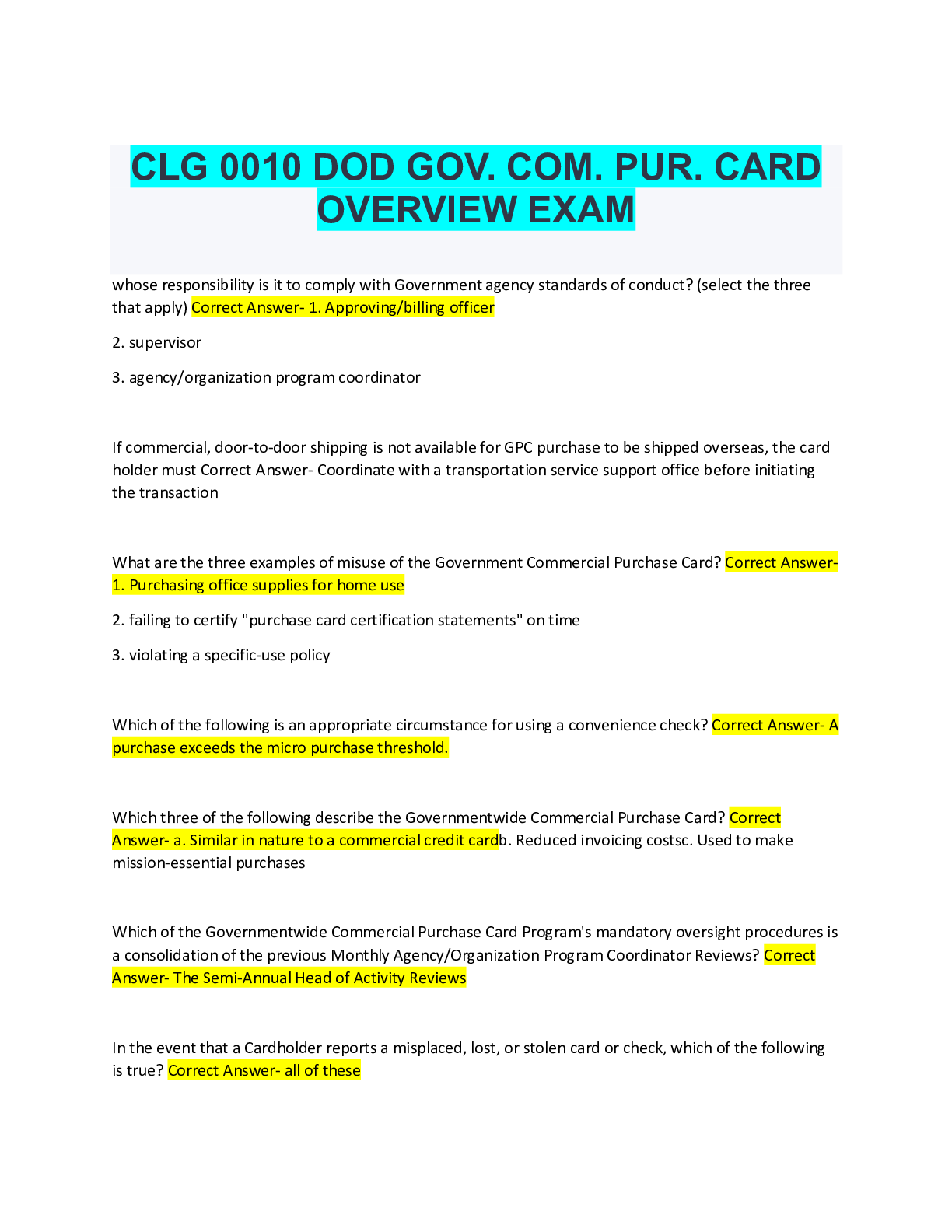



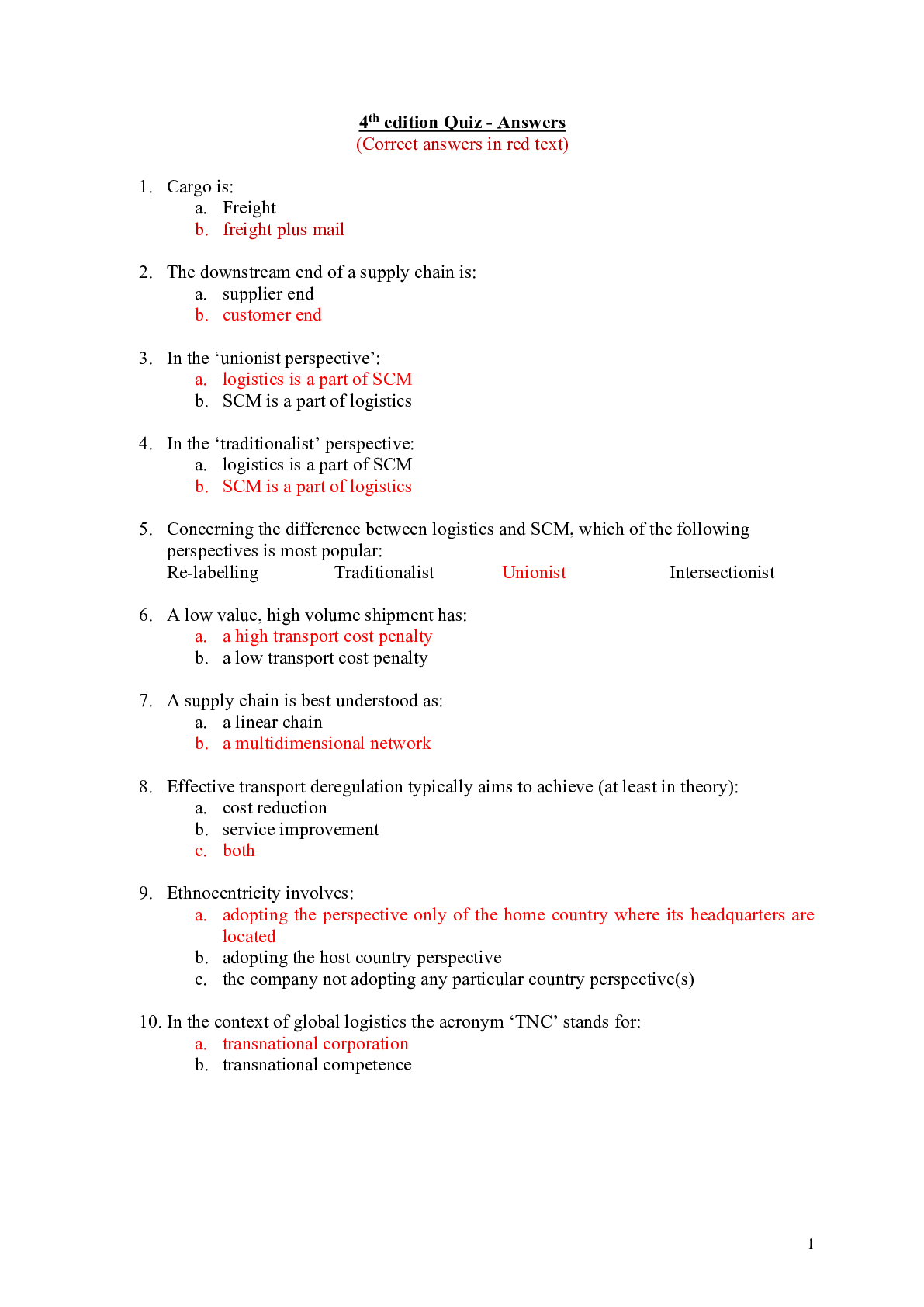
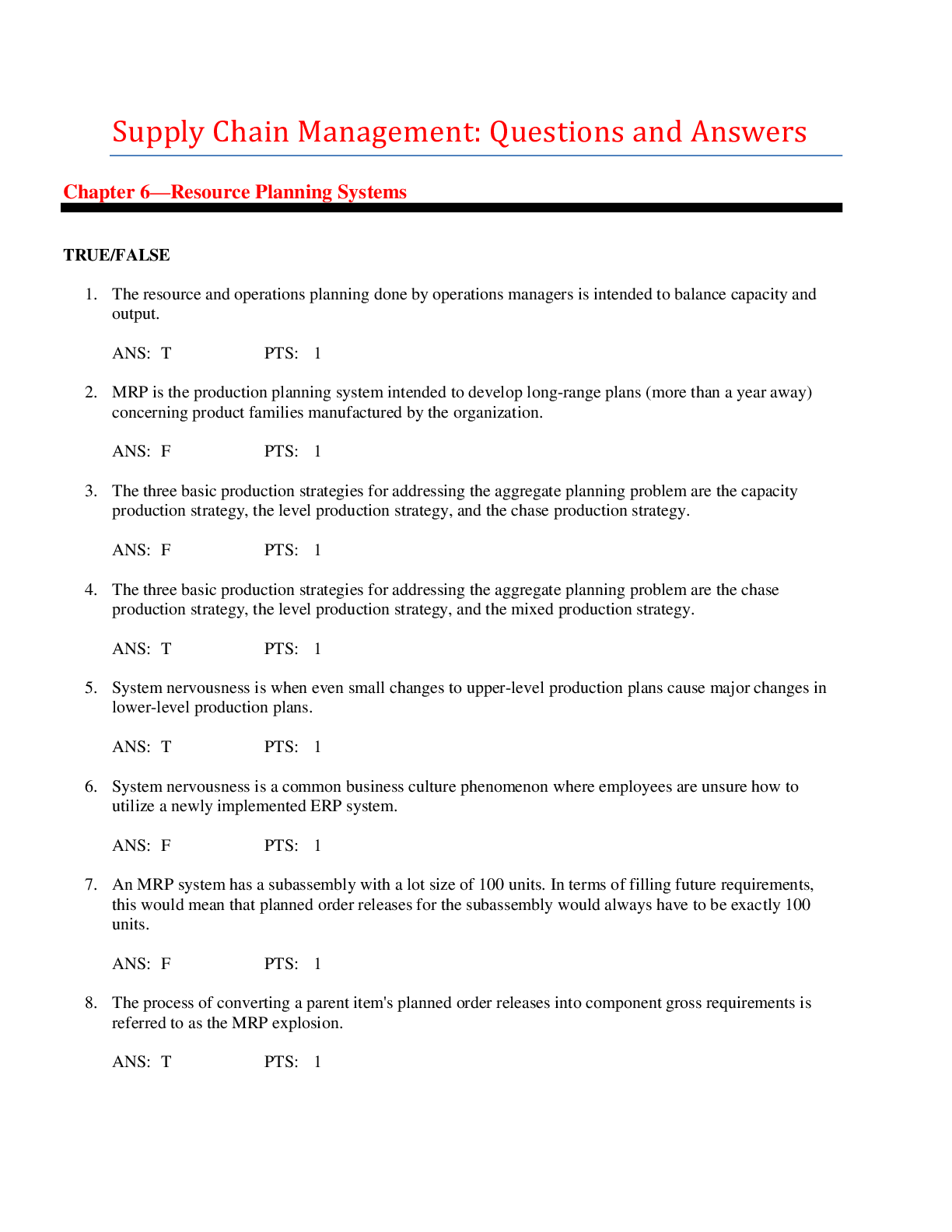
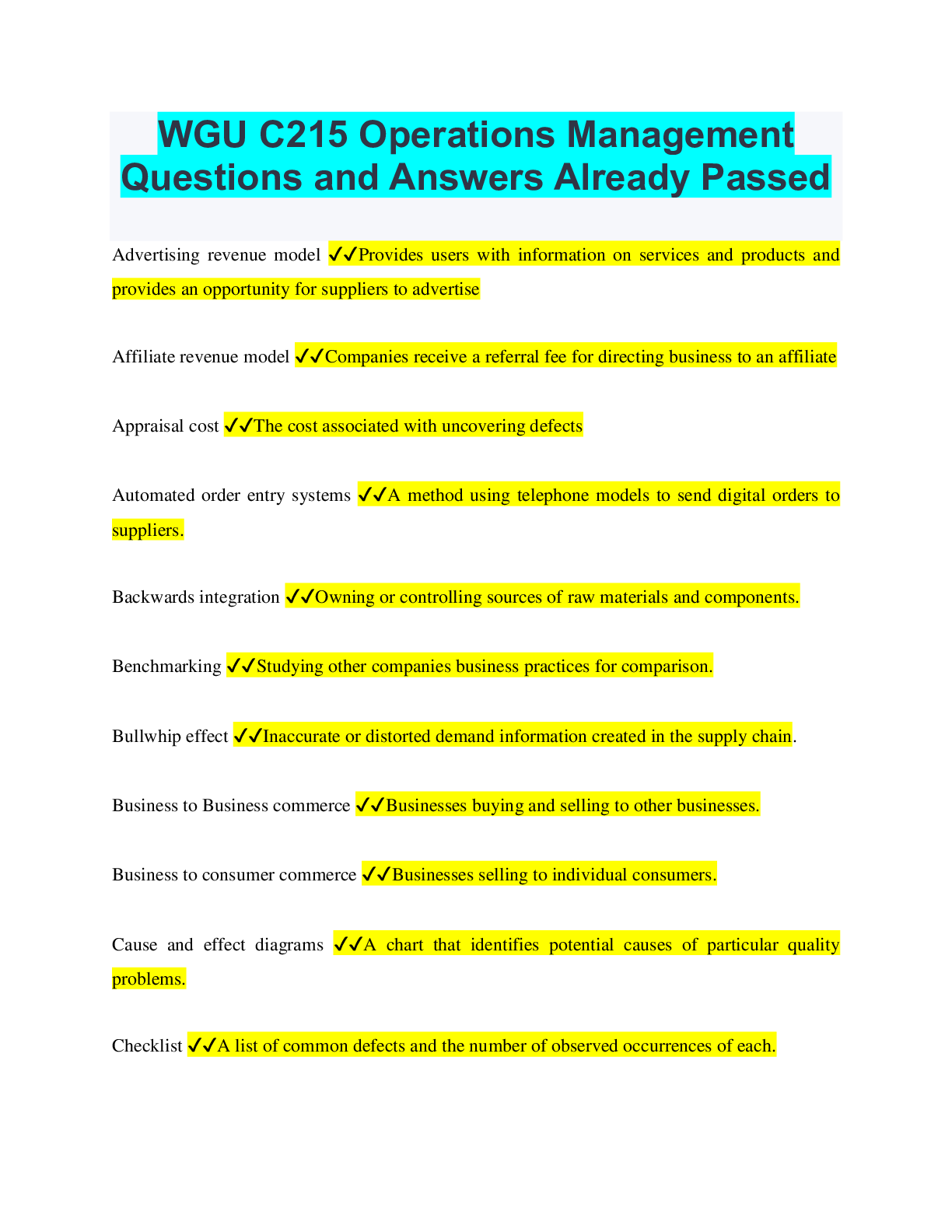
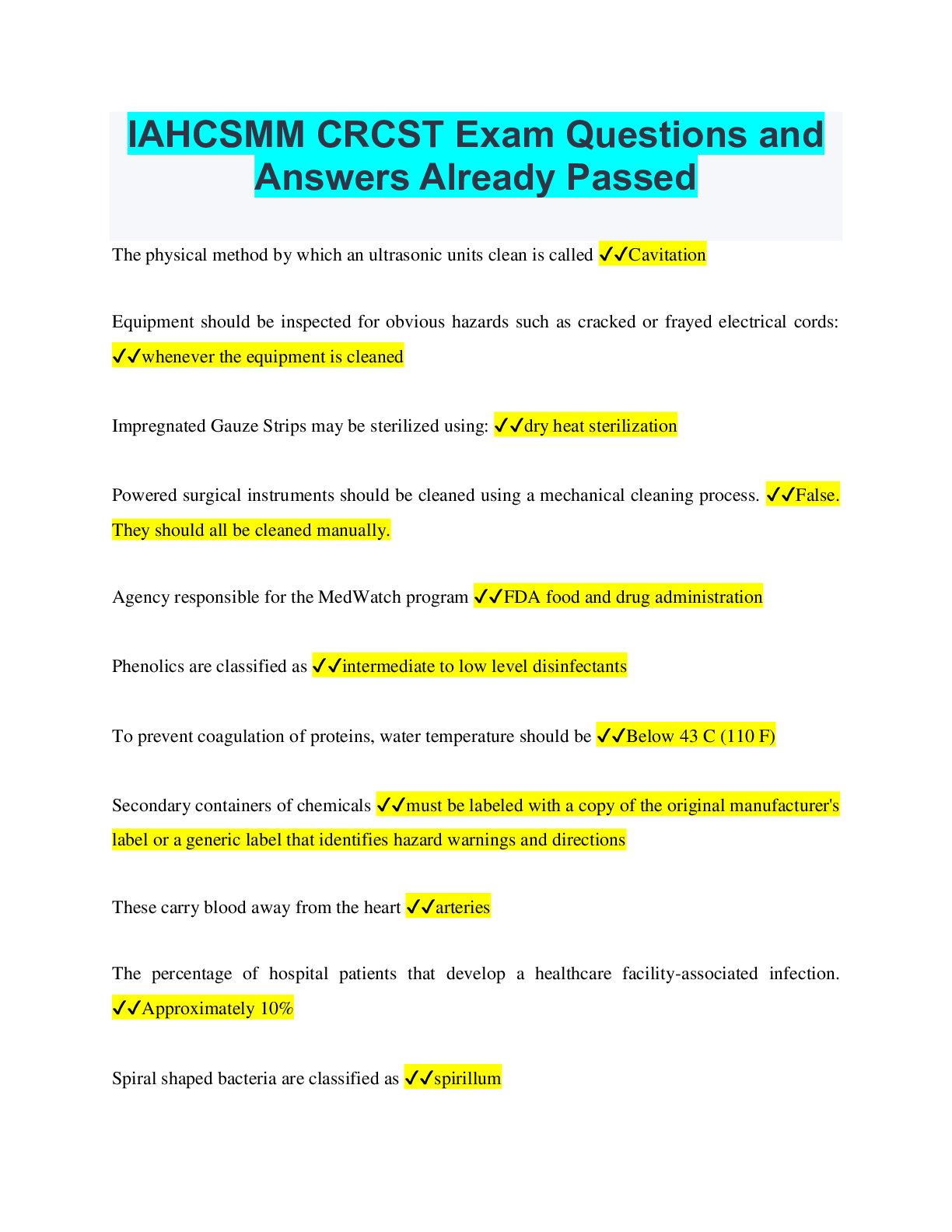

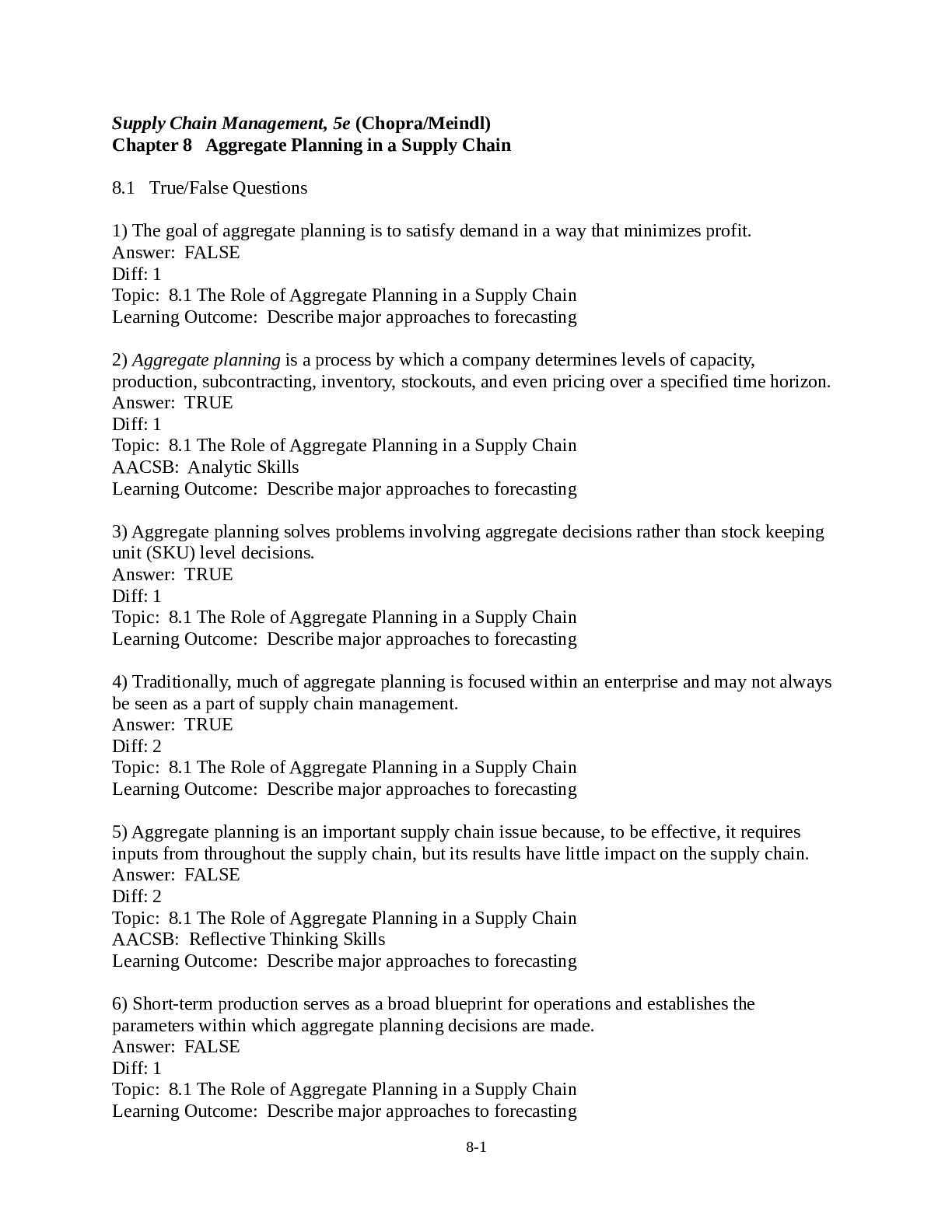
.png)


